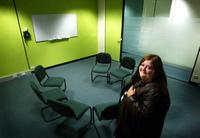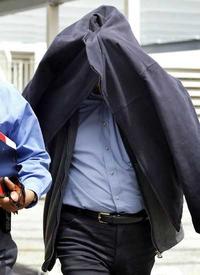
Forensic psychologist Karen Owen in the Green Room where sex offenders
are treated.
Photo:Angela Wylie
Web of shame
October 9, 2004

Photo: Sharon Smith
Australia's biggest investigation into online child pornography is far from over. Who downloads these images and why do they do it? Ian Munro and Catharine Munro report.
The Green Room is in an unremarkable office building on the edge of the CBD. Sign-free and anonymous. There is nothing to suggest this is the headquarters of Corrections Victoria's sex offender program.
The Green Room is, strictly, a misnomer; it refers only to the bilious colour of the door of the otherwise neutral-coloured treatment room. Along the corridor is a second treatment room, the Orange Room.
Behind these garish doors, convicted sex offenders, including internet child porn consumers, wrestle with their demons in group sessions run by two therapists and observed through a two-way mirror by students and still more therapists.
In the past five years, the centre, managed by forensic psychologist Karen Owen, has treated 58 men convicted of possession of internet child pornography. That figure will almost certainly leap following Australia's biggest child pornography investigation, Operation Auxin, which last week co-ordinated raids on 400 homes across the country, yielding more than 2 million pornographic images of children aged from two to 16. Those under investigation include academics, teachers, church ministers and public servants. Six suspects are known to have killed themselves in the wake of the raids.
The head of the state's sexual crimes squad, Detective Inspector Tony Cecchin, this week said that in Victoria alone at least 89 men were expected to face charges. After the raids, Crime Stoppers in Victoria received more than 100 tip-offs about new suspects.
Should all 89 of those interviewed so far be charged and convicted, they will represent an extraordinary potential resource for researchers into the nascent world of internet porn. Little is known about internet child porn consumers, partly because widespread use of the internet is a recent phenomenon, so it is unclear what proportion of collectors and viewers progress to actual child abuse.
Child porn consumers who do not directly abuse still contribute to abuse, experts stress.
Already, the recent raids have highlighted a couple of potent lessons.
Lesson One for the uninitiated: in the world of pedophilia and child pornography, even a Kmart catalogue, with its numerous pictures of child models, has currency.
Lesson Two: the internet, by providing often socially inadequate, friendless and isolated consumers of child pornography with what passes for a community and mutual understanding, may increase the likelihood of them offending.

Forensic psychologist Karen Owen in the Green Room where sex offenders
are treated.
Photo:Angela Wylie
Of course, an image does not necessarily have to be pornographic, Karen Owen says. It is what the viewer brings to it that matters. "It's quite innocent for a dad to take a picture of a child in a bath. But it's really the meaning and the sexualisation an individual puts to that photo that's the issue.
"The internet child porn investigation has brought attention to illicit porn, but the men we work with will use anything that arouses them. The ones we are catching are the ones that have illicit images, but some men can sexualise anything.
"There's a huge number of men who collect Kmart catalogues because they use pictures of children."
The internet has changed things, Owen says. It has made more explicit images more accessible.
Also, the internet plays into a key characteristic of sex offenders generally - their lack of social skills and intimacy, their personal isolation. "The internet provides a degree of security and anonymity that allows you to seek out people with similar views," Owen says. "It provides a social element which they would not have had access to before. That in itself reinforces their social inadequacy, but it also reaffirms their interest."
The most basic lesson about offenders, however, is that they are mostly unknown. Are they abused as children? Yes and no. Do they progress to abusing children themselves? Sometimes. Can they maintain adult relationships, and appear normal? Often no, but sometimes yes.
While the relationship between internet pornography and pedophilia remains unclear, research published last year tentatively concluded that the more images individuals possessed, and the more organised and catalogued they were, the more likely the offenders were to progress to physical abuse. A US study of 2577 arrests for online juvenile victimisation, published last November, found that more than two-thirds of all those who sexually violated juveniles possessed child pornography.
The study, conducted by the Crimes Against Children Research Centre at the University of New Hampshire, said 36 per cent of the arrests related exclusively to trading internet child pornography. The rest were for soliciting police posing as minors, for sex crimes such as assault where the internet helped bring about a meeting and for producing child porn.
Child porn consumers who do not directly abuse children still contribute to abuse, experts stress, by creating a market for porn. There is no such thing as victimless child porn, they say, with the possible exceptions of digitally altered pictures and cases such as that of the West Australian prisoner who wrote a series of explicit stories describing sex acts with children, which he supplied to another prisoner.
Dr Tony Krone, a research analyst at the Australian Institute of Criminology, in a paper published last July, says the prisoner pleaded guilty to child porn charges, although his sentence was reduced because no child was actually involved.
Krone says the number of images held by an individual is not sufficient to gauge the seriousness of the offence of possessing child pornography.
"There are other indicators of seriousness, such as the offender's engagement with the material," he writes.
"This may include how long it has been held, the degree to which it is organised by the offender, how it was acquired, and whether it is a trophy of the offender's own sexual abuse of a child."
Krone says there is a range of online child porn offenders. At one end are the browsers who might encounter material unintentionally but keep it. Then there are collectors of vast numbers of images protected by passwords and encryption. And then there are the "groomers" who make contact with a child online and try to prepare them for sexual contact by exposure to sexual images.
"It is not possible to say whether the advent of the internet has fuelled the demand for child pornography and expanded an existing market, or whether it simply satisfies in new ways a market that would have existed in any event," Krone says.
"It is clear, though, that the internet provides an environment for the proliferation of child pornography and the creation of an expanding market for its consumption."
Psychiatrist Lester Walton notes the collectors whose gathering of material appears almost an obsessive end in itself.
"Some of these fellows have thousands of pictures which they don't look at that often, but which they catalogue extensively. There's a significant number where there's never been any wrongdoing with a child directly, although obviously there is a child at the end of it."
It is not only men who offend in this way. The Victorian treatment centre has seen two women who used child pornography immediately before they offended against young children.
Possession of child pornography, describing or depicting children under 16 years old, was introduced as an offence in Victoria in 1995, with a maximum penalty of five years' jail. The recent raids relied on information from an international investigation led by the FBI. Since early last year, US customs officials and the FBI have been unravelling internet links to child pornography websites run by Russian organised crime groups.
Relying on credit-card details and computer links, the FBI tipped off the Australian Federal Police, and since April this year police nationwide had planned for a week of raids on 717 suspects, of whom 176 were in Victoria. Only 89 have so far been questioned, although sexual crimes squad head Inspector Cecchin says police have found enough information to support 111 warrants.
Material uncovered in the raids across Victoria has yet to be fully analysed, Cecchin says, but it is known to include depictions of bestiality and penetration. One individual had more than 120,000 images in his possession.
"The vast majority of the porn thus far, and this may change, but the vast majority has come from overseas," he says. "I believe in other states they may have discovered studios and manufacturing. In Victoria, we have not, but we may be charging some offenders with abuse and molestation of children."
However, the raids have attracted criticism from civil liberties groups. Liberty Victoria president Greg Connellan says it was extraordinary that people whose property was searched but were yet to be charged had already been identified in the media.
He says the seriousness of the investigation only reinforced the need to protect the identities of those under investigation before they were charged. Connellan was critical of the media for naming two school teachers this week.
"Hysteria might be the wrong word, but there's certainly serious concern in the community. When one thinks about the worst forms of pornography and how the children have been treated and the long-term effects, one can understand the public response. It's because of those things people should not be inappropriately identified."
The Corrections Victoria program that takes place behind the green and orange doors caters for a broad range of sex offenders, including those found guilty of indecent exposure, sexual assault, rape and crimes relating to internet pornography.
An overseas assessment of a similar sex offender program found that it halved the rates of re-offending, although after eight years in Victoria, it is still too soon to make those claims for the local version.
Treatment is effective, forensic psychologist Karen Owen says, and it does not necessarily need a willing subject. The program seeks to teach offenders how to recognise the stresses that might trigger their offending. "The first thing is to teach them to recognise that stress is why they are doing it. It's about changing that emotional state."
Offenders are also taught to empathise with their victims, to confront the harm that they perpetrate.
Often the last fatal link may be some stressful incident such as a relationship breakdown that ends in their offending. A key element in treatment is teaching the offender to recognise, and avoid, the conditions that lead to their crimes.
To assist in that, they must create a support network of family, friends and acquaintances that will either alert them or authorities to situations that are likely to result in their re-offending.
This means they must reveal to family and friends in precise detail how they go about their crimes, how they set them up and what exactly they do. This unsparing revelation takes place in the Green Room or the Orange Room, in the company of therapists.
It is at this juncture, Owen says, that many of the wives who have stood by their man decide it is time to leave. At this point, there is no place left for any self-delusion.
Victoria already has a long-established specialised taskforce of five detectives and an analyst who work with computer crime investigators in tracking internet porn. Tip-offs from overseas watchdog groups and from within Australia have prompted past prosecutions.
Computer repair shops have also tipped off police, but last week's revelations may result in new strategies to combat internet child porn.
"This is going to be a long and drawn-out process now, because never before in the history of Victoria and Australia has the demand on our resources and capacity been called upon to analyse this level of material," Cecchin says.
"This will be a unique opportunity to analyse evidence and hopefully come up with some research ideas about what makes these people tick."